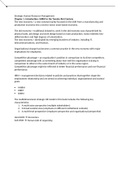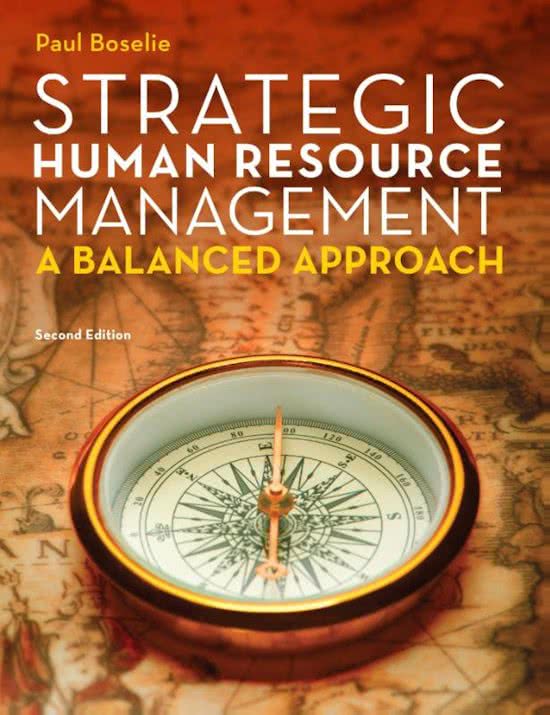Strategic Human Resource Management
Chapter 1. Introduction: SHRM in the Twenty-first Century
The new economy = a new concept mainly focused on the shift from a manufacturing and
production economy into a service sector asset-based economy.
The old economy = traditional industries, work in the old economy was characterized by
physical tasks, job design and work design based on mass production, many relatively low-
skilled workers and high degrees of unionization.
The new economy = dominated by emerging branches of industry, including IT,
telecommunications, and finances.
Organizational change has become a common practice in the new economy with major
implications for employees.
Competitive advantage = an organization’s position in comparison to its direct competitors,
competitive advantage tells us something about how well the organization is doing in
comparison to others in the same branch of industry or in the same region.
Competitive advantage might be reflected in better financial performance and non-financial
performance.
HRM = management decisions related to policies and practices that together shape the
employment relationship and are aimed at achieving individual, organizational and societal
goals.
MHRM
IHRM
SHRM
The multidimensional strategic HR model in this book includes the following key
characteristics:
1. A multi-actor perspective (multiple stakeholders)
2. A broad societal view (emphasis on different institutional contexts)
3. A multi-level perspective (employee perspective and organizational perspective)
Hard HRM Economics
Soft HRM Human side of organizing
,Lecture 1.
HR performance cycle = investing in people is positively related to success.
HRM has been in the executive board since around 30 years.
Stakeholders:
- Employee
- Employer
- Unions (important in some countries, e.g. the Netherlands (poldermodel =
continuous negotiations))
- Government
- Clients/customers
- Shareholders
- Institutional context (retirement age, healthcare system, social security system)
Organizational change
Acquisitions
Mergers
Reorganizations Impact on organizations
Strategic alliances Impact on employees
Private equity interventions
Global crisis
Financial crisis
Ageing population, e.g. Asian countries have a lot of respect for elderly (wisdom), they
know how to deal with coping strategies.
The relevance of optimal coping with change is embedded in the concept of competitive
advantage.
Competitive advantage:
- Is important for organizational survival.
- Is at least partly manageable by human resource management.
Internationalization, informationalization, individualization, intensification, informalization
High performance work systems
In the past, HR focused on one specific aspect, now we know from research that particular
bundles have positive influence on competitive advantage.
Breach employment = people almost retiring start working less hours. Imagine your career
stops tomorrow, and you have no purpose in life anymore.
Three HRM perspectives
1. Micro HRM
2. International HRM
3. Strategic HRM
Micro HRM = individual employee = covers the sub functions of HR policy and practice
including recruitment and selection, induction and socialization, and training and
,development. MHRM is closely related to the studies in Organizational Behavior and
Occupational Psychology often focused on the impact of single HR practices on employee
attitudes and behaviors.
International HRM = MNCs = concerned with HRM in multinational companies and HRM
across borders. IHRM is focused on issues such as the transferability of HR practices across
business units in different countries, the optimal management of expatriates and the impact
of different institutional country contexts on human resource management.
Situational leadership = type of leadership focusing on different styles of leadership
depending on the context, e.g. repatriation management.
Strategic HRM = alignment between organizational goal and the goal of the employee =
focuses on issues of linking HRM to the business strategy, designing high performance work
systems and adding value through good people management in an attempt to gain sustained
competitive advantage. The concept of ‘fit’ plays a central role within SHRM.
SHRM is responsible for making sure the goals of the employee are achieved, (1) happy, (2)
healthy, (3) productive.
Three perspectives in studying SHRM practices (= systemic approach)
1. Multi-actor perspective (multiple stakeholders, including employees, managers, HR
professionals, work councils, trade unions, top management, shareholders, financiers
and government)
2. Broad societal view (with an emphasis on different institutional contexts, e.g. on the
level of branches of industry, regions and countries, retirement age, some
professions have a certain code of conduct)
3. Multi-level perspective (including the individual employee perspective and the
strategic organizational perspective) + team interaction
Paauwe (2004) Paauwe launched the HRM field.
- Human resources are something more than just ‘resources’, not just instrumental
resources, employees have emotions.
- Human resource management is not concerned solely with financial performance, e.g.
lifelong employability (schooling, learning) and respect (genuine respect).
- Human resource management focuses on the exchange relationship between employee
and organization, e.g. reward your employer for being trusted.
Psychological contract = relationship between you and your organization.
OCB = Organization Citizenship Behavior, OCB increases when you feel well.
In-job / Extra role behavior = what you do on top of the in-job tasks.
- And the shaping of the employment relationship takes place in an era of continuous
tension between the added value and moral values.
Boxall & Purcell (2008) Boxall & Purcell have written the Master’s book.
- HRM covers all workforce groups, including core employees, peripheral employees and
contingent workers, e.g. cleaners, flex workers, but also managers.
- HRM involves line and specialist managers, and is not solely aimed at employees.
- HRM is all about managing work and people, collectively and individually.
- HRM is embedded in industries and societies.
, Special management development programmes = traineeship
Young employees change organization more frequently, but get traineeships for free more
often than older employees.
The balanced approach
In the strategic balance model, organizational success can only be achieved when financial
performance and societal performance of an organization are above average in the
particular population in which the organization is operating.
The balanced approach in HRM
Goals of the individual employee
Organizational goals
Societal goals






